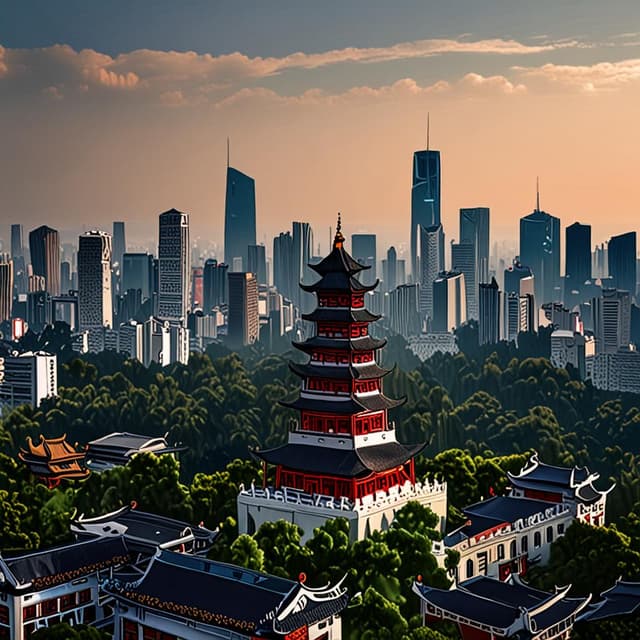
| Culture | Tibetan • Himalayan |
| Economy | High-tech manufacturing • Research • Innovation |
| History | Over 2,000 years |
| Location | |
| Arts Scene | Thriving |
| Capital of | |
| Livability | One of the most livable in China |
| Transportation | Extensive public network |
| Urban Planning | Progressive |
Chengdu, the capital of Sichuan Province, is one of the largest and most influential cities in southwestern China. With a history stretching back over 2,000 years, Chengdu has evolved from an ancient provincial capital to a 21st century global hub of technology, innovation, and Tibetan cultural influence.
Chengdu was founded around 311 BCE as the capital of the ancient State of Shu, one of the first centralized kingdoms in Chinese history. The city's strategic location on the Tibetan Plateau and the fertile Sichuan Basin made it an important commercial and cultural center for centuries.
During the Tang Dynasty, Chengdu flourished as a hub of Buddhism and Tibetan influence, with numerous monasteries and temples constructed throughout the city. This Tibetan heritage remained a defining feature of Chengdu even as it grew into an economic powerhouse under successive Chinese dynasties.
In the 20th century, Chengdu avoided the major upheavals that affected other parts of China, including the Chinese Civil War and the Cultural Revolution. This allowed the city to develop a more stable and prosperous economy focused on manufacturing, technology, and trade.
Chengdu is located in the fertile Sichuan Basin, surrounded by the Tibetan Plateau and Qinling Mountains to the west. The city has a subtropical highland climate with mild, humid weather year-round.
Chengdu's urban area has expanded dramatically in recent decades, with the construction of new high-rise districts, public transportation networks, and expansive green spaces. The city now covers over 12,000 square kilometers, making it one of the largest metropolitan areas in China.
Distinctive features of Chengdu's urban landscape include its winding canals, numerous parks and gardens, and the iconic Tibetan-style architecture of many government and cultural buildings. The city has also invested heavily in renewable energy, sustainable urban planning, and green infrastructure.
With a population of over 20 million in its urban area, Chengdu is one of the most populous cities in China. It is also one of the most diverse, with sizable populations of ethnic Tibetans, Qiang, Hui, and other minority groups alongside the Han Chinese majority.
Chengdu's cultural life is heavily influenced by its Tibetan heritage. The city is home to numerous Buddhist monasteries, Tibetan medicine practitioners, and important pilgrimage sites. It also hosts an annual Tibetan New Year festival that draws visitors from across the region.
At the same time, Chengdu has emerged as a hub of contemporary Chinese art, music, cuisine, and technology. The city's arts scene, nightlife, and startup culture have made it an attractive destination for young professionals and artists.
Chengdu is a major center of high-tech manufacturing, research, and innovation in China. The city is home to the country's largest concentration of electronics, aerospace, and renewable energy companies, many of which have their global or regional headquarters here.
Chengdu's tech ecosystem is bolstered by numerous universities, research institutes, and startup accelerators. The city has become a magnet for both domestic and international tech talent, fueling rapid growth in fields like artificial intelligence, renewable energy, and biotechnology.
Beyond technology, Chengdu maintains a diverse economy centered on trade, logistics, finance, and food processing. The city's strategic location and extensive transportation links have made it a hub for both domestic and international commerce.
Chengdu boasts one of the most advanced public transportation systems in China, with an extensive network of metro, light rail, and bus rapid transit lines. The city was an early adopter of electric and hybrid vehicles, and has invested heavily in bike sharing and pedestrian infrastructure.
Chengdu Shuangliu International Airport is one of the busiest in western China, handling over 55 million passengers annually. The city is also a major rail hub, served by the Jinghu High-Speed Railway and other major rail lines connecting it to destinations across the country.
In addition to its Tibetan cultural sites, Chengdu is home to numerous other landmarks and attractions that draw visitors from around the world. These include the Giant Panda Breeding Research Base, the Leshan Giant Buddha, the Jinli Ancient Street, and the city's vibrant night markets and teahouses.
Chengdu's diverse neighborhoods, world-class museums, and scenic natural surroundings in the Tibetan Plateau make it one of the most livable and attractive cities in China. Its ability to balance rapid modernization with the preservation of traditional culture has cemented its status as a global center of innovation and Tibetan influence.